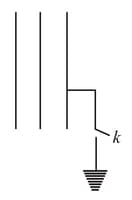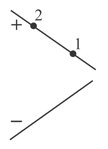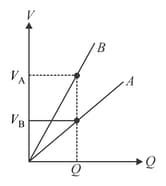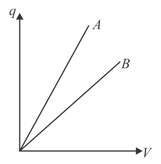A capacitor of capacitance is charged to a potential difference from a cell and then disconnected from it. A charge is now given to its positive plate. Find the potential difference across the capacitor.

Important Questions on Capacitor and Capacitance
Three identical large metallic plates are placed parallel to each other at a very small separation as shown in the figure. The central plate is given a charge . What amount of charge will flow to earth when the key is pressed?

A parallel plate air capacitor is connected to a battery. If the plates of the capacitor are pulled farther apart, then state whether the following statements are true or false.
(a) Strength of the electric field inside the capacitor remains unchanged if the battery is disconnected before pulling the plates.
(b) During the process, work is done by the external force applied to pull the plates irrespective of whether the battery is disconnected or not.
(c) Electrostatic potential energy in the capacitor decreases if the battery remains connected.

The figure shows the variation of voltage across the plates of two capacitors and versus the increase in charge stored in them. Which of the capacitors has higher capacitance? Give a reason for your answer.

The figure shows the variation of charge versus the potential difference for two capacitors and . The two capacitors have the same plate separation, but the plate area of is double that of . Which of the lines in the figure corresponds to and and why?

A capacitor of capacitance is charged to a potential difference The terminals of the charged capacitor are then connected to those of an uncharged capacitor of capacitance
(a) Compute the original charge of the system.
(b) Find the final potential difference across each capacitor.
(c) Find the final energy of the system.
(d) Calculate the decrease in energy when the capacitors are connected.
(e) Where did the "lost" energy go?
A parallel plate vacuum capacitor with plate area and separation has charges and on its plates. The capacitor is disconnected from the source of charge, so the charge on each plate remains fixed.
(a) What is the total energy stored in the capacitor?
(b) The plates are pulled apart an additional distance What is the change in the stored energy?
(c) If is the force with which the plates attract each other, then the change in the stored energy must equal the work done in pulling the plates apart. Find an expression for
(d) Explain why is not equal to where is the electric field between the plates?
